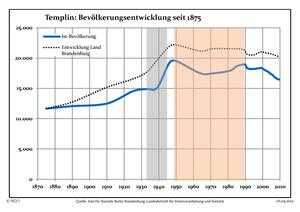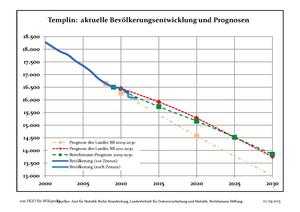Templin
| Templin | ||
|---|---|---|
| ||
 Templin | ||
Location of Templin within Uckermark district  | ||
| Coordinates: 53°07′0″N 13°30′0″E / 53.11667°N 13.50000°ECoordinates: 53°07′0″N 13°30′0″E / 53.11667°N 13.50000°E | ||
| Country | Germany | |
| State | Brandenburg | |
| District | Uckermark | |
| Subdivisions | 24 Ortsteile | |
| Government | ||
| • Mayor | Ulrich Schoeneich (Ind.) | |
| Area | ||
| • Total | 377.01 km2 (145.56 sq mi) | |
| Elevation | 60 m (200 ft) | |
| Population (2012-12-31)[1] | ||
| • Total | 16,063 | |
| • Density | 43/km2 (110/sq mi) | |
| Time zone | CET/CEST (UTC+1/+2) | |
| Postal codes | 17268 | |
| Dialling codes | 03987, 039882, 039883 | |
| Vehicle registration | UM | |
| Website | www.templin.de | |
Templin is a small town in the Uckermark district of Brandenburg, Germany. Though it has a population of only 17,127 (2006), it is with 377.01 km2 (145.56 sq mi) the second largest town in Brandenburg (after Wittstock) and the seventh largest town in Germany by area. The town is located in the south of the rural Uckermark region and its capital Prenzlau, north of the Schorfheide-Chorin Biosphere Reserve. The municipality comprises the villages of Ahrensdorf, Bebersee, Beutel, Densow, Gandenitz, Gollin, Gross Dölln, Gross Väter, Grunewald, Hammelspring, Herzfelde, Hindenburg, Klosterwalde, Petznick, Röddelin, Storkow and Vietmannsdorf.
History

The town was first mentioned in a 1270 deed issued by Henry of Ostheeren, Bishop of Brandenburg. Then a possession of the Ascanian margraves of Brandenburg, it appeared as a town in 1314 under Margrave Waldemar, who in 1317 concluded the Treaty of Templin here, ending the war against Denmark, Mecklenburg and the Duchy of Pomerania. Heavily devastated by Danish troops in the Thirty Years' War, Templin from 1816 on belonged to the Prussian province of Brandenburg near the border with Mecklenburg-Strelitz.

From 1912 on, Templin was the seat of the Electoral Brandenburgian boarding school (Joachimsthalsches Gymnasium) established in 1601 by Elector Joachim III Frederick of Hohenzollern at nearby Joachimsthal. The school was finally dissolved in 1953. Today, Templin has a modern grammar school built in 1997.
Demography

-

Development of Population since 1875 within the Actual Boundaries (Blue Line: Population; Dotted Line: Comparison to Population Development of Brandenburg state; Grey Background: Time of Nazi rule; Red Background: Time of Communist rule)
-

Recent Population Development (Blue Line) and Forecasts

Points of interest

Templin's city walls are small, but complete. There are 3 main gate towers and several modern entrances, where parts of the wall were torn down. The main Protestant church is the Marien Kirche. The town has many eastern era Plattenbau houses (highrise apartments) and smaller neighborhoods.
The Lehmann-Garten, a botanical garden was recreated in 1988 in the park of the former Joachimsthalsches Gymnasium.
Hermann Göring from 1933 on had his country residence Carinhall erected in the forest south of Gollin. The building designed by Werner March was destroyed by Luftwaffe personnel in April 1945, just days before the Red Army reached the area.

North of Groß Dölln is an airfield built in the 1950s as a military airbase of the 16th Air Army of the Soviet Forces
Templin has recently built a spa and mainly relies on tourism. It is a popular destination for day-trippers from Berlin to enjoy the many glacial lakes and extended forests. There is no discothèque in Templin, the closest is in Milmersdorf. The town square with the old town hall building is surrounded by an active downtown. There are many shops and restaurants in the area and an outdoor market every week. Many neighbouring municipalities like Milmersdorf and several other villages rely on Templin for many services.
Twin towns
 Bad Lippspringe, Germany
Bad Lippspringe, Germany Połczyn-Zdrój, Poland
Połczyn-Zdrój, Poland Controguerra, Italy
Controguerra, Italy Newbridge, Ireland
Newbridge, Ireland
Notable people
- Friederike Krüger, Prussian soldier, died 1848 at Templin
- Walter Ulbricht, died 1973 at Groß Dölln
- Werner Pusch (1913–1988), politician, was born at Templin
- Angela Winkler, actress, born 1944 at Templin
- Manfred Kokot, Olympic athlete, born 1948 at Templin
- Angela Merkel, German chancellor, from 1957 grew up in Templin
See also
References
- ↑ "Bevölkerung im Land Brandenburg nach amtsfreien Gemeinden, Ämtern und Gemeinden 31. Dezember 2012 (XLS-Datei; 83 KB) (Einwohnerzahlen auf Grundlage des Zensus 2011)". Amt für Statistik Berlin-Brandenburg (in German). 31 December 2012.
External links
![]() Media related to Templin at Wikimedia Commons
Media related to Templin at Wikimedia Commons
